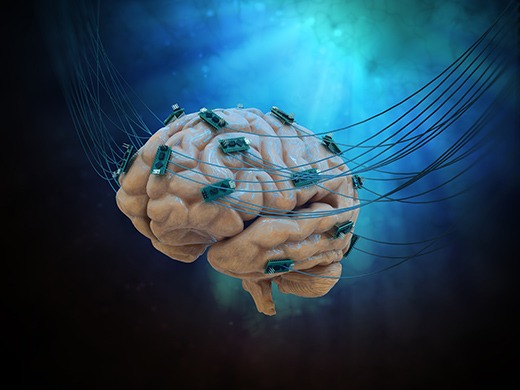
Neurotechnology: Connecting the Human Brain to the Internet.
Neurotechnology is revolutionizing human potential by merging the brain with digital systems, enabling thought-controlled devices, memory enhancement, and even direct connectivity to the internet. This rapidly advancing field promises breakthroughs in medicine, communication, and learning, while raising profound ethical, security, and societal questions about privacy, identity, and the boundaries between human cognition and machine intelligence.
✨ Raghav Jain

The Dawn of a New Era: Understanding Neurotechnology (1000 words)
Imagine thinking of a word, and your computer types it for you. Imagine paralyzed patients controlling robotic limbs or smartphones directly with their thoughts. This is no longer science fiction—it’s neurotechnology, a rapidly evolving field that merges neuroscience with digital innovation to establish direct communication between the human brain and external devices, potentially connecting our very minds to the Internet itself.
At its core, neurotechnology refers to tools and systems designed to monitor, influence, or simulate brain activity. The goal is to bridge the biological and the digital—essentially allowing two-way data exchange between neurons and machines. The most advanced form of this concept is the Brain-Computer Interface (BCI), which decodes brain signals and translates them into commands that computers or prosthetics can understand.
The basic science behind BCIs is fascinating. Our brain communicates through billions of neurons that transmit signals via tiny electrical impulses. Neurotechnologists use electrodes—either implanted directly into brain tissue or placed externally on the scalp—to detect and record these signals. Algorithms then interpret this neural activity, translating it into actionable data such as cursor movement, robotic control, or even direct digital communication.
Projects like Elon Musk’s Neuralink, Synchron’s Stentrode, and Blackrock Neurotech are leading this revolution. Neuralink, for example, has developed a coin-sized chip implanted in the skull that interfaces with thousands of brain neurons. The company envisions a future where users can control computers, send messages, or even stream their thoughts to the cloud—all without moving a muscle. Synchron’s Stentrode, on the other hand, takes a less invasive approach, inserting a neural device through blood vessels to connect brain signals to external devices wirelessly.
However, neurotechnology isn’t just about convenience—it’s about restoration and empowerment. Medical applications have already shown remarkable promise. BCIs are helping quadriplegic patients regain partial mobility, allowing them to control prosthetic limbs or type messages using only thought. Cochlear implants, one of the earliest forms of neurotechnology, have restored hearing to thousands of people by converting sound waves into electrical impulses sent directly to the auditory nerve.
Another groundbreaking frontier is neural rehabilitation. After a stroke or spinal injury, neuroprosthetics can reroute brain signals to bypass damaged areas, effectively rewiring neural pathways. For patients with neurodegenerative diseases like ALS or Parkinson’s, these technologies offer new hope—enabling communication or improving movement when traditional medicine reaches its limits.
Yet, the vision of connecting the brain directly to the Internet opens profound possibilities beyond healthcare. Researchers foresee “neural internet” systems where information can be uploaded or downloaded directly into the brain. Imagine learning a new language or complex skill simply by “downloading” it from a cloud server. While this idea is still speculative, early experiments with memory implants and optogenetics suggest it may someday become possible.
Moreover, the concept of a collective consciousness network—where multiple human minds are connected digitally—has been explored in lab settings. Experiments like the BrainNet project at the University of Washington have demonstrated direct brain-to-brain communication between individuals through neural signals transmitted over the internet. This could lead to new forms of collaboration, empathy, or even telepathic communication powered by data.
But before this grand vision becomes reality, several monumental challenges stand in the way. The human brain is the most complex structure in the known universe, containing about 86 billion neurons. Decoding its intricate patterns accurately, safely, and consistently is a massive scientific and ethical challenge. Moreover, invasive neural implants carry significant medical risks such as infections, scar tissue, and potential long-term damage to neural tissue.
On the computational side, securely transmitting brain data over the internet requires encryption protocols far more advanced than anything currently in existence. The stakes are much higher than traditional cybersecurity breaches—if brain data can be intercepted or manipulated, it could literally mean hacking into someone’s mind. This raises deep ethical and philosophical questions about privacy, consent, and identity in a world where thoughts might be shared or accessed digitally.
Ethics, Risks, and the Future of Brain-Internet Connectivity
The dream of a connected mind is as thrilling as it is terrifying. As neurotechnology progresses, it brings not only potential miracles of science but also unprecedented ethical dilemmas. The ability to read, record, and potentially influence thoughts touches on the very essence of what it means to be human.
One major concern is mental privacy. In a world where brain data becomes a new form of digital information, who owns that data? Can it be sold, stored, or shared? If thoughts can be tracked or decoded, could employers, governments, or corporations misuse this capability for surveillance or manipulation? The fear of “thought hacking” is not science fiction anymore—it’s a looming concern among ethicists and neuroscientists alike.
There’s also the issue of identity and autonomy. If our brains are connected to external networks, where do “we” end and the machine begins? The merging of human cognition with artificial intelligence could blur the boundaries between natural thought and programmed response. Over time, constant connectivity could lead to dependency on digital systems for memory, decision-making, or even emotion regulation.
From a societal perspective, the potential for inequality is another issue. If neuro-enhancements become commercially available, those who can afford brain-linked technologies might gain cognitive advantages over others—creating a new digital divide based not just on wealth, but on neurological capability. This could lead to a class of “neuro-elite” individuals with enhanced mental faculties, memory, or creativity, widening social and intellectual inequality.
Ethical frameworks are now being developed to address these concerns. The OECD and UNESCO have proposed guidelines emphasizing the importance of safeguarding “neurorights”—the right to cognitive liberty, mental privacy, psychological integrity, and protection from algorithmic bias. Countries like Chile have even started incorporating neurorights into their constitutions, setting a precedent for the rest of the world.
Technologically, the road ahead is both promising and perilous. Future BCIs are expected to become wireless, minimally invasive, and AI-integrated, enabling real-time brain-cloud interaction. Advances in nanotechnology may allow microscopic neural dust or nanosensors to be injected into the brain, creating massive neural data streams that can communicate with digital systems seamlessly. With AI algorithms analyzing these signals, machines might eventually predict or even anticipate human intentions.
The combination of Artificial Intelligence and Neurotechnology (AI+Neurotech) could unlock unimaginable potential. Imagine AI-driven implants that monitor emotional states and automatically adjust brain chemistry to treat depression, anxiety, or addiction. Cognitive augmentation could also enable faster learning, enhanced creativity, and even digital telepathy—where individuals share ideas instantly through a neural network.
However, with great power comes great responsibility. Governments and tech companies must collaborate to ensure these technologies are developed with strict ethical oversight, transparency, and data security measures. Regulatory frameworks need to evolve as quickly as the technology itself to prevent misuse and protect individual freedom.
From a philosophical perspective, connecting the brain to the Internet also challenges our understanding of consciousness and humanity. If memories can be backed up, shared, or transferred, does that make consciousness a transferable entity? Would we still be “us” if part of our cognition lived in the cloud? These questions—once confined to speculative fiction—are now entering scientific debate.
As we look ahead, it’s clear that neurotechnology is not merely another tech revolution; it’s a transformation of human evolution itself. It may one day redefine communication, learning, medicine, and even identity. Whether this future becomes a utopia of enhanced minds or a dystopia of lost autonomy depends on how humanity navigates the moral crossroads it now faces.
In the 21st century, a new scientific frontier is taking shape—one that merges the intricacies of the human mind with the boundless power of digital technology. Neurotechnology, often described as the bridge between biology and machine, is redefining what it means to think, communicate, and even exist. At its essence, neurotechnology refers to the science and engineering of interfacing directly with the human brain to record, interpret, and influence its activity. This revolutionary field combines neuroscience, computer science, artificial intelligence, and bioengineering to enable two-way communication between neurons and external devices—an interaction that could soon allow humans to connect their thoughts directly to the internet. Imagine controlling a smartphone or a robotic limb using only your mind, or transmitting your thoughts to another person without speaking a word. What once seemed the domain of science fiction is now rapidly becoming a tangible reality through Brain-Computer Interfaces (BCIs). A BCI works by decoding the brain’s electrical impulses, which are generated by billions of neurons communicating through chemical and electrical signals. These impulses can be detected using electrodes placed either on the scalp (non-invasive) or implanted directly into the brain tissue (invasive). Once recorded, complex algorithms translate these signals into commands that computers or machines can understand—essentially turning thoughts into digital instructions. Companies like Neuralink, Synchron, and Blackrock Neurotech are leading this neurotechnological revolution. Neuralink, founded by Elon Musk, has developed a coin-sized implant capable of reading thousands of brain signals simultaneously. The long-term vision includes allowing users to control digital devices, communicate telepathically, and perhaps even access online information directly from their neural activity. Synchron’s “Stentrode” implant, on the other hand, offers a minimally invasive alternative that can be inserted through blood vessels, enabling paralyzed patients to operate computers wirelessly. Such technologies are already changing lives—helping individuals with spinal cord injuries regain control of their environment, or allowing those with ALS to communicate by thought alone. Yet beyond medical restoration lies the promise of human enhancement. Imagine a future where learning is instantaneous—where languages, musical skills, or complex scientific knowledge could be downloaded directly into the brain from the cloud. Scientists have already demonstrated primitive memory implants in animal models, hinting at the possibility of uploading and retrieving memories like files. The implications are staggering: from improving education and cognitive performance to merging collective human intelligence into a shared neural network. Experiments like the BrainNet project have already enabled basic brain-to-brain communication via the internet, where participants transmitted decisions and problem-solving information using only neural signals. This kind of direct “thought sharing” could one day transform collaboration, empathy, and creativity. But such possibilities also open Pandora’s box of ethical and philosophical dilemmas. Connecting the brain to the internet transforms the concept of privacy in ways previously unimaginable. When brain signals can be decoded, our inner world—our emotions, intentions, and memories—ceases to be completely private. The risk of “mind hacking,” where unauthorized access to brain data becomes possible, presents a chilling scenario. Just as cybercriminals steal passwords today, the thought of hackers manipulating or extracting one’s thoughts tomorrow raises profound security concerns. This gives rise to the concept of neurorights, a new category of human rights designed to protect mental privacy, cognitive liberty, and psychological integrity. Nations like Chile have already incorporated neurorights into law, setting a precedent for future global regulation. Another concern is identity and autonomy. When our thoughts and decisions can be influenced by digital systems, where do we draw the line between human will and machine intervention? Will a person augmented by AI still be fully human—or something else? As BCIs evolve, they may not only interpret thoughts but also stimulate the brain to evoke emotions, memories, or sensations. While this can treat mental health conditions like depression or PTSD, it also raises the risk of external control over one’s consciousness. Philosophers argue that the essence of being human lies in our independent thought processes; blurring that boundary could redefine individuality itself. Moreover, neurotechnology threatens to deepen global inequality. If cognitive-enhancing implants become commercially available, those who can afford them might gain unfair advantages in education, employment, or creativity, leading to a new class divide between “neuro-augmented” and “non-augmented” humans. In this light, the pursuit of brain-internet connectivity is not just a technological race—it’s a moral and social one. Nevertheless, the potential benefits are undeniable. For medical science, neurotechnology is already a miracle-maker. BCIs have enabled paralyzed patients to walk again with robotic exoskeletons, blind individuals to perceive light through visual prosthetics, and deaf patients to hear via cochlear implants. Deep Brain Stimulation (DBS) has successfully treated Parkinson’s disease and severe depression by delivering targeted electrical impulses to specific brain regions. As AI becomes more integrated into neurotech, these systems could become adaptive—analyzing neural patterns in real-time to provide personalized treatments for neurological disorders, addiction, or mental illness. Looking forward, the integration of nanotechnology may push these possibilities even further. Researchers envision neural dust—microscopic sensors that can be injected into the bloodstream to monitor brain activity or repair neural damage at the cellular level. With wireless communication, these nano-implants could connect directly to cloud-based AI systems, creating a continuous brain-internet interface. Such a future raises another deep question: if part of our mind exists in the cloud, where does consciousness truly reside? Could a person’s identity survive beyond their biological body if memories or thought patterns were uploaded to a digital medium? The merging of AI and human cognition might lead to the rise of a new hybrid species—part biological, part digital—capable of collective intelligence on a scale humanity has never known. However, this evolution must proceed with caution. Cybersecurity frameworks, ethical governance, and psychological research must advance alongside the technology. Developers must prioritize data encryption, informed consent, and transparent algorithms to prevent misuse. Governments and global organizations like UNESCO and the OECD are already working on ethical guidelines to ensure responsible innovation in neurotechnology. Still, regulation often lags behind invention, and the rapid pace of progress means vigilance is essential. Ultimately, connecting the human brain to the internet is more than a scientific milestone—it’s a civilizational turning point. It holds the power to cure, enhance, and transform, but also to manipulate, exploit, and redefine what it means to be human. Whether it becomes a tool of liberation or control will depend on the ethical wisdom and collective responsibility of society. The mind, once confined within the boundaries of the skull, is now reaching toward the digital cosmos—and humanity must decide how far it should go.
In an era defined by rapid scientific progress, no field captures the imagination quite like neurotechnology—the science of linking the human brain with digital systems, and ultimately, the Internet itself. This ambitious pursuit aims to create seamless two-way communication between neurons and machines, potentially allowing humans to send, receive, and process information directly through thought. At its core, neurotechnology is powered by Brain-Computer Interfaces (BCIs)—devices that decode neural activity and translate it into digital commands. Our brain contains roughly 86 billion neurons that communicate through electrical impulses, creating patterns that represent everything from emotions to motor control. By capturing these patterns with electrodes—either externally via electroencephalography (EEG) caps or internally via implanted microelectrodes—scientists can interpret brain activity, feeding it into computers, prosthetics, or even the internet. This process, once theoretical, is now rapidly becoming reality. Companies like Neuralink, founded by Elon Musk, are pioneering advanced brain implants that can read thousands of neurons simultaneously, with the long-term vision of enabling humans to control devices, communicate telepathically, and access online information directly through their thoughts. Neuralink’s prototype—an implant smaller than a coin—has already shown promise in restoring mobility to paralyzed patients by translating their thoughts into movement commands for robotic limbs. Similarly, Synchron, another neurotechnology firm, has developed the “Stentrode”—a minimally invasive brain implant that can be inserted through blood vessels, allowing patients with paralysis to send text messages and browse the internet wirelessly using only their thoughts. These technologies, once confined to the realm of science fiction, are transforming medicine, offering unprecedented ways to treat neurological disorders such as ALS, Parkinson’s disease, and epilepsy. Beyond healthcare, neurotechnology holds the potential to dramatically expand human capability. Imagine learning new skills or languages instantly by downloading them from a neural cloud, or sharing thoughts and emotions with others through direct brain-to-brain communication. This concept, sometimes referred to as the “neural internet”, envisions a world where ideas, experiences, and memories can be transmitted as easily as emails. Early experiments like the BrainNet project at the University of Washington have already demonstrated rudimentary brain-to-brain communication, where participants cooperatively solved problems by transmitting neural signals over the internet. In time, this could evolve into collective intelligence networks, where humans collaborate and think together in unprecedented ways. Yet, while the potential benefits are astonishing, the risks are equally immense. Directly connecting the brain to digital systems introduces profound ethical and security concerns. The brain, unlike any other organ, houses our identity, thoughts, and consciousness. Once neural data becomes digitized, the risk of hacking, surveillance, and manipulation becomes a terrifying possibility. If external systems can read or influence brain activity, what becomes of mental privacy? Who owns one’s thoughts? Could a person’s emotions or memories be altered by external interference? These questions have given rise to the emerging concept of neurorights—fundamental rights that protect cognitive liberty, mental privacy, and psychological integrity. Chile became the first country to enshrine neurorights in its constitution, signaling the urgency of addressing these concerns before neurotechnology reaches mainstream adoption. Another major challenge lies in defining human autonomy in a world where machines can influence thought and behavior. If artificial intelligence begins to interpret and respond to our brain activity, could it also begin to shape our decisions subconsciously? This raises unsettling questions about free will and authenticity in human experience. Moreover, the integration of neurotechnology could deepen social inequality. Access to brain-enhancing technologies will likely be limited to those who can afford them, potentially creating a “neuro-elite” class with superior cognitive abilities. This would not only amplify economic and educational disparities but could redefine power dynamics across society. Philosophically, the implications are even more profound. If the brain can be backed up, transferred, or connected to an artificial substrate, does consciousness become something that can exist beyond the biological body? Could humans achieve a form of digital immortality by uploading their neural patterns into the cloud? These once-speculative questions are now being seriously discussed among neuroscientists and ethicists as the boundaries between organic and artificial intelligence blur. On a more optimistic note, neurotechnology also offers transformative medical and psychological benefits. BCIs have already enabled paralyzed individuals to walk using robotic exoskeletons, restored partial vision to the blind, and treated chronic depression through deep brain stimulation (DBS). As artificial intelligence becomes integrated into neurotech systems, devices will become increasingly adaptive—able to predict emotional states, detect mental health issues, and offer real-time neural interventions. In this context, the fusion of AI and neurotechnology represents not just an upgrade of human capability but a potential evolution of human consciousness itself. Future innovations may rely on nanotechnology—such as neural dust, microscopic sensors that can be injected into the bloodstream to monitor and modulate brain activity wirelessly. These nano-implants could connect the human mind to cloud-based computing systems, allowing for real-time data sharing between the brain and the internet. Imagine a world where your thoughts could interface with AI assistants, search engines, or even other human minds in milliseconds. However, with such transformative power comes immense responsibility. The human brain is not just a biological processor—it is the seat of identity, emotion, and experience. Any interference with its processes carries deep ethical weight. Governments, scientists, and corporations must collaborate to establish robust ethical guidelines and security frameworks to prevent misuse. Regulation must evolve as rapidly as the technology itself, ensuring transparency, consent, and accountability at every stage of development. Ultimately, the dream of connecting the brain to the internet is not simply a technological leap—it is a philosophical and existential one. It promises to revolutionize communication, education, medicine, and even the essence of what it means to be human. But it also forces us to confront uncomfortable truths: if our thoughts can be shared, who controls them? If knowledge can be downloaded, what happens to curiosity? And if consciousness can exist in digital form, does death lose its meaning? Neurotechnology may one day grant us godlike access to knowledge and creativity, but it also demands humility, ethics, and self-awareness. Whether it leads to enlightenment or enslavement will depend on how responsibly humanity wields this power. As we stand on the threshold of a future where mind meets machine, one truth becomes clear—the next evolution of humanity will not occur in our bodies, but in our brains.
Conclusion
Neurotechnology represents one of the most groundbreaking frontiers in human history—where biology meets machine, and thought meets data. The ability to connect the human brain to the Internet holds vast potential for healing, empowerment, and evolution. From restoring mobility in the paralyzed to potentially downloading knowledge, the scope of this technology is boundless.
However, the risks are equally profound. Ethical dilemmas surrounding mental privacy, autonomy, and inequality must be addressed before widespread adoption. Society must ensure that such advancements serve humanity rather than enslave it to digital systems. The future of neurotechnology depends on balancing innovation with integrity, science with ethics, and progress with protection.
The brain-internet connection could become humanity’s next leap—or its greatest cautionary tale. The choice lies in how wisely we shape this technology.
Q&A Section
Q1: What is neurotechnology?
Ans: Neurotechnology is the integration of neuroscience and technology to monitor, interpret, or influence brain activity, enabling direct communication between the brain and external devices.
Q2: How does a brain-computer interface (BCI) work?
Ans: A BCI records electrical signals from neurons using electrodes, decodes them via algorithms, and translates them into commands that control digital devices or prosthetics.
Q3: What are the medical benefits of neurotechnology?
Ans: It helps restore movement in paralyzed patients, assists in neurorehabilitation after strokes, treats neurological disorders, and enables communication for individuals with severe disabilities.
Q4: Can the human brain really connect to the Internet?
Ans: While full brain-to-Internet connectivity is still in early stages, experiments have demonstrated brain-to-computer and even brain-to-brain data transmission, suggesting it’s possible in the near future.
Q5: What are the ethical concerns of neurotechnology?
Ans: Major issues include mental privacy, data security, cognitive autonomy, and social inequality arising from unequal access to cognitive enhancement technologies.
Similar Articles
Find more relatable content in similar Articles

Holographic Displays: Will You..
“Exploring the Future of Commu.. Read More

Neurotechnology: Connecting th..
Neurotechnology is revolutioni.. Read More

E-Ink Smartphones: The Next Mi..
E-Ink smartphones are redefini.. Read More

The Psychology of Digital Addi..
Digital addiction is a growing.. Read More
Explore Other Categories
Explore many different categories of articles ranging from Gadgets to Security
Smart Devices, Gear & Innovations
Discover in-depth reviews, hands-on experiences, and expert insights on the newest gadgets—from smartphones to smartwatches, headphones, wearables, and everything in between. Stay ahead with the latest in tech gear
Apps That Power Your World
Explore essential mobile and desktop applications across all platforms. From productivity boosters to creative tools, we cover updates, recommendations, and how-tos to make your digital life easier and more efficient.
Tomorrow's Technology, Today's Insights
Dive into the world of emerging technologies, AI breakthroughs, space tech, robotics, and innovations shaping the future. Stay informed on what's next in the evolution of science and technology.
Protecting You in a Digital Age
Learn how to secure your data, protect your privacy, and understand the latest in online threats. We break down complex cybersecurity topics into practical advice for everyday users and professionals alike.
© 2025 Copyrights by rTechnology. All Rights Reserved.